Maira de Sa Kaye — Conservation Steward — SCA NH Corps
What would the world be, once bereft
Of wet and wildness?
Let them be left,
O let them be left, wildness and wet;
Long live the weeds and the wilderness yet
—Gerard Manley Hopkins
1) Foraging wild plants should be done in a limited, respectful, and ethical manner to not harm the ecosystem in which one is foraging; do not forage a plant that is rare, do not take all the berries from a bush. For safety, do not eat a plant unless you are 100% sure you know what it is. Consult field guides and ask a more experienced forager if unsure.
2) Many of the plants discussed here were used by Native Americans as both poisons and medicines. Though this may sound paradoxical to modern ears, this is in fact the meaning of the word drug (or its Greek equivalent, pharmakon); it all depends on the dosage. In Western medicine as well, too much of a medication can be fatal. These plants should not be used as medicines unless prescribed by a licensed herbalist.
3) I spent my early years of life in the Northeastern United States but lived in Brazil for most of my teenage and adult life. Coming to New Hampshire to serve as a Conservation Steward for NH State Parks and AmeriCorps with the SCA NH Corps has given me the chance to learn about the natural world of my childhood.
· · ·
It is mid-May. I just arrived in New Hampshire, and as I take walks around Bear Brook State Park, I am constantly learning about the plants that inhabit the natural communities of NH’s forests. On every trail, wild blueberry bushes (Vaccinium angustifolium, heath family) are sprinkled with white-belled flowers, indicating that in about a month’s time we can expect an abundance of yummy berries (the leaves also make for good tea). Each morning, the team gathers for a stretch circle in a grassy field with tiny four-petaled pale blue flowers with a yellow center like a watercolor droplet. These little damsels are known as bluets or Quaker ladies (Houstonia caerulea, coffee family), and are edible; they made a great snack for those chilly dewy mornings (tasting of crunchy water, like alfalfa sprouts).
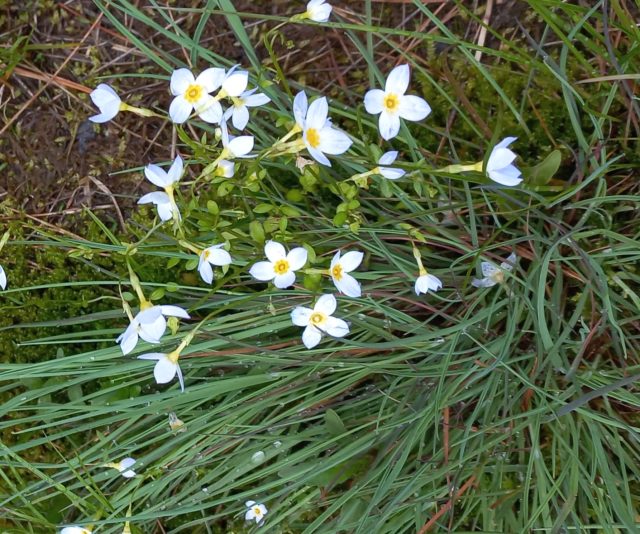
In my adventures through the park, I discovered more native plants. My eyes caught the light purple fringed poligable (Polygala paucifolia, milkwort family), also known as gay wings, with its two symmetrical orchid-like three-petaled flower (two of which look like wings); the red columbine (Aquilogia canadensis, buttercup family), which many mistake for a honeysuckle, but is poisonous. The white 7-petaled starflower (Trientalis borealis, primrose family) with its whorl of 5 or more lance-shaped leaves, very similar to the leaves of the Indian cucumber (Medeola virginiana, lily family). The latter gains a second tier of leaves when it flowers (note: a starflower without a flower and an Indian cucumber without a second tier of leaves are almost indistinguishable). Both plants reproduce through rhizomes that grow under ground — those of the Indian cucumber are edible, and are a crunchy garlicky cucumber trail snack.
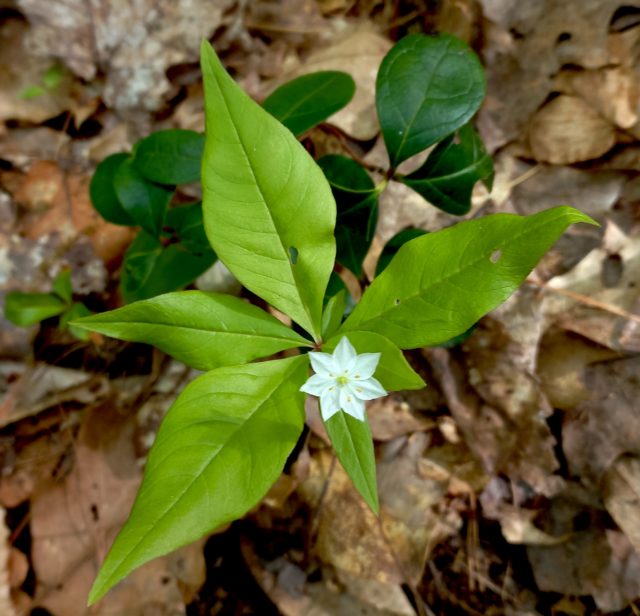
Walking on the Ridge Trail, I came across the pink lady’s slipper (Cypripedium acaule, orchid family), the New Hampshire state wildflower, for the first time. Later, while doing campsite assessments in the Pemigewasset Wilderness, I would find yellow and white lady slippers in abundance along the Thoreau Falls Trail. The delicately veined pink flower pops out among the foliage, attracting not only contemplative human eyes but pollinators as well. Pollinators enter the orchid in search for nectar and pollinate it by being forced to exit through its reproductive parts.
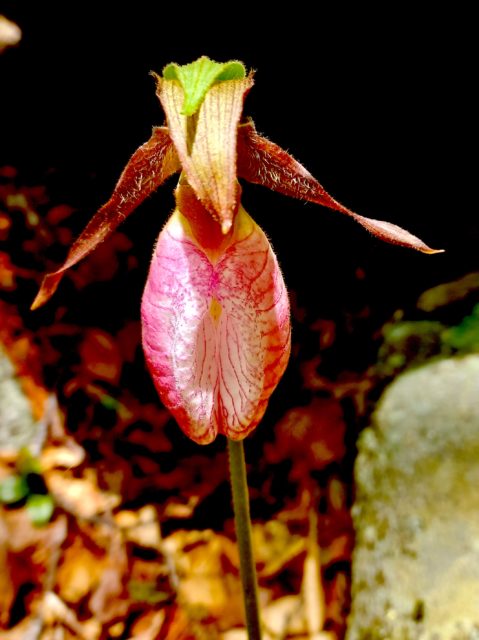
· · ·
In June, as a Conservation Steward for the SCA, I went on my first “hitch” of the season assisting the Squam Lake Association with trail improvements on the Old Bridle Path. I camped with my crew on a peninsula by the lake covered in the most gorgeous white flowers decorated with thin pink lines —mountain laurel (also known as spoonwood or calico bush, Kalmia latifolia, heath family, closely related to the equally poisonous rhododendron and azalea). The area had the prime conditions for the plant to thrive: acidic soil, shade, and wetness. Everywhere I walked, its perfume filled the air and its white flowers starkly contrasting to its dark green leaves were a delight to the eye. Caution as these plants are extremely poisonous.
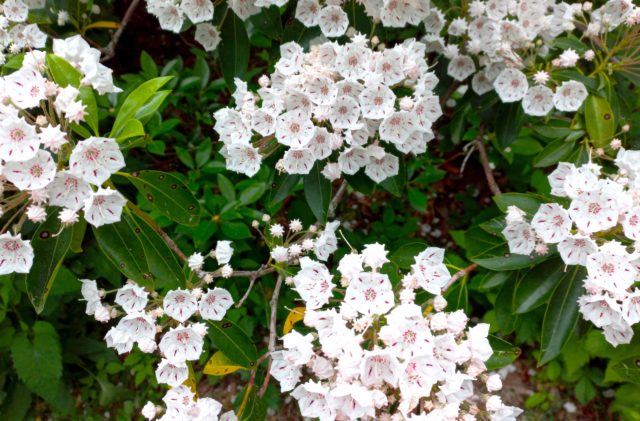
At Squam I also discovered another, less dangerous, traditional medicinal Native American plant: yarrow (Achillea millefolium, aster family), which was used by many indigenous tribes, including the Abenaki, as anti-inflammatory medicine. The tea I made from its leaves and flowers made me feel energized and present. After first finding yarrow at Squam, I began to see it on roadsides all across the state, since it grows in dry, disturbed soil.
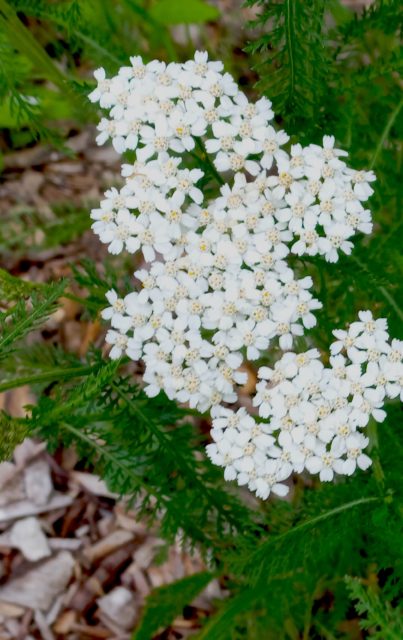
During my fourth hitch, surveying campsites in the Wild River Wilderness, the trails offered me blueberries, raspberries, and bunchberries to power me along the way. You certainly have heard of the first two berries, but may be wondering what are bunchberries? These are the bright orange, somewhat fruity, berries of the creeping dogwood (Cornus canadensis, dogwood family). In May, I had noticed its leaves and flowers, which are exactly like those on the dogwood tree, but as a small flowering plant at ground-level. The white flowers of spring turn to orange berries of summer.
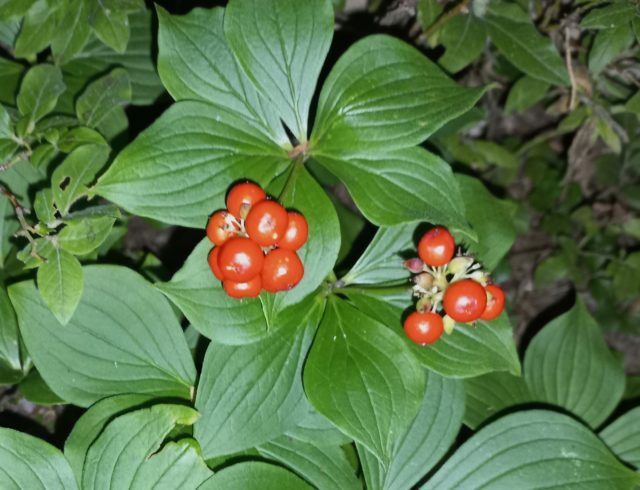
I also chewed on some tasty wood sorrel leaves (Oxalis montana, wood sorrel family). Some may mistake them for clover leaves (which are also edible; the flowers, however, are completely different), but wood sorrel is much tastier (it secretes a lemony vinegar juice when you crunch down on it).
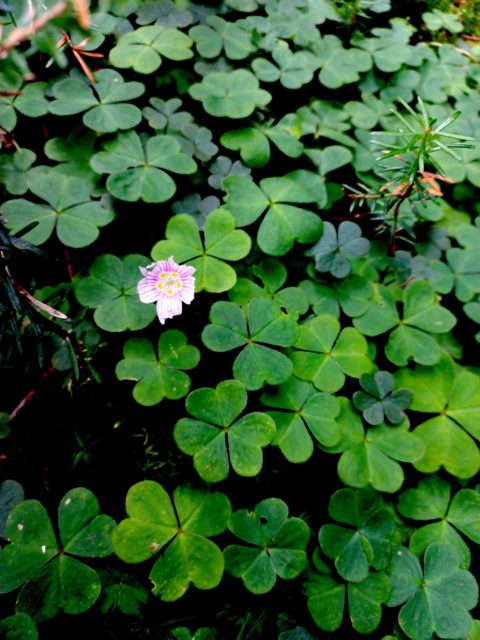
During a visit to Jericho State park, I was delighted to try pin cherries (Prunus pensylvanica, a cherry species native to North America)for the first time. Like wild blueberries, they are smaller than store-bought cherries and concentrate their sourness and sweetness in a burst of pin-sized flavor.[1]
Inspired by these trail snacks, I tried identifying plants that I found in the White Mountains with interesting-looking berries. For the most part, what I found could not be eaten. The bright candy-looking blue berries of the corn lily (Clintonia borealis, lily family), are said to be poisonous.[2]
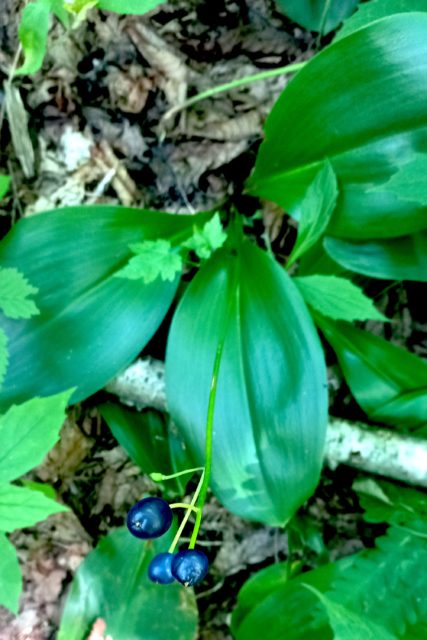
The captivating red fruit of the painted trillium (Trillium undulatum, lily family) are more appetizing to ants, who carry and disperse their seeds, than to humans.
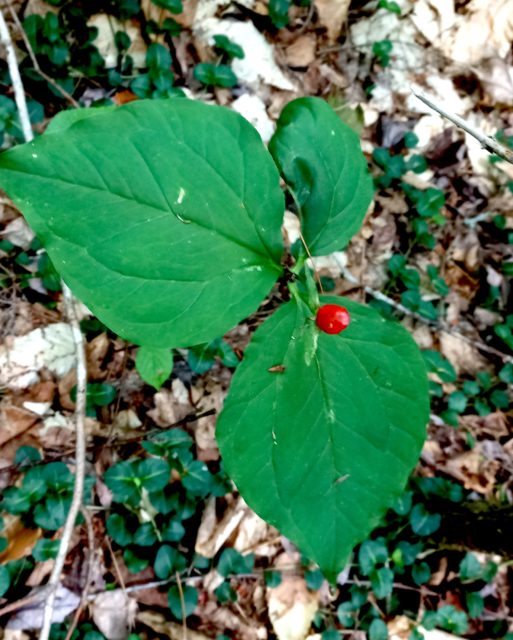
On a trail in the Wild River Wilderness, both red and white baneberry (Actaea rubra and A. pachypoda, buttercup family) caught my eye, with the glossy gleam of their berries identified by a distinctive black dot in the middle. A quintessential pharmakon, the plant’s berries were used by Native Americans as arrow poison, while its root was used as a medicine for stomach troubles by practitioners of traditional medicine.
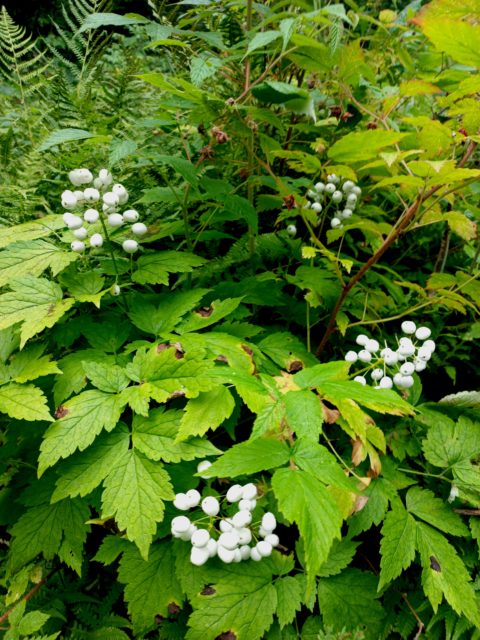
Near the top of Mt. Monadnock, I admired the beautiful reddish-yellowish berries of the mountain holly tree (Ilex mucronata, holly family), which, like most hollies, is poisonous. The one edible berry that I have found on rocky sparsely vegetated sub-alpine mountain-tops in the White Mountains is the creeping mountain cranberry (also called as lingonberry or cowberry, Vaccinium vitis-idaea, heath family), which is a hardy plant known to survive in harsh areas such as the Arctic tundra.
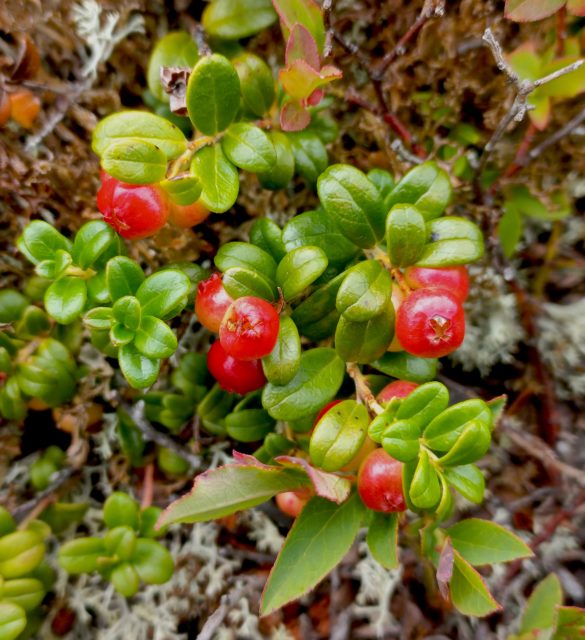
· · ·
Lastly, I would like to discuss the most fascinating plant that I have learned about during my time here in New Hampshire. Due to the acidic soil that covers most of the state, it harbors many members of the heath family (scientifically named Ericaceae; we have encountered them: blueberries, mountain laurel, rhododendron, mountain cranberry). The plants in this family typically display ovate leaves along their stems. Yet one species in the family looks like it does not have any leaves at all – it does, they are translucent. In fact, when I first observed it, I was under the impression that it was some kind of mushroom: Monotropa uniflora, known as “ghost pipe”, or “Indian pipe”.
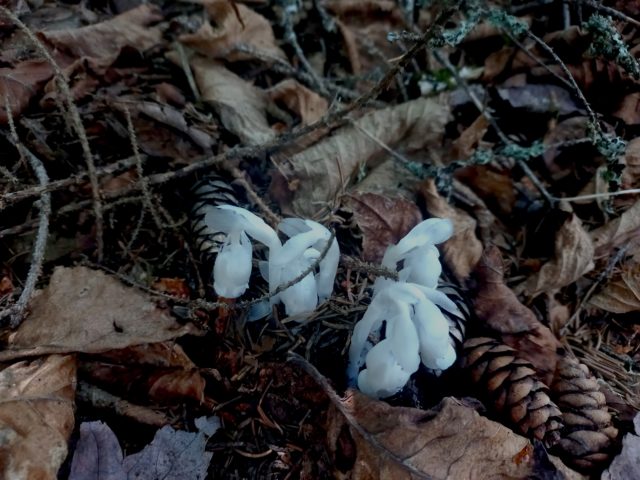
Now that I know to which family the ghost pipe belongs, I can see that its drooping white bell-shaped flowers are indeed similar to the shape of blueberry flowers. A non-photosynthetic plant, the ghost pipe lacks the chlorophyll necessary to absorb energy from the sun, and instead consumes the organic matter generated by mycorrhizal fungi which in turn consume it from surrounding trees. I wasn’t that far off in thinking it was a mushroom, since it does indeed consume energy in a manner more like fungi like photosynthetic plants! It also grows in shady, moist places as do many mushrooms. According to the Native American Ethnobotany Database, the root was used as an anti-convulsive, cold remedy, and painkiller by certain tribes (Cherokee, Mohegan, and Cree),[3] but since the plant contains glycoside, which can be toxic, consumption is not advisable.[4]
It is therefore wiser to stick to trustworthy blueberries for now, and to leave ghost pipes for poetry, art, and contemplation.
‘Tis whiter than an Indian Pipe —
‘Tis dimmer than a Lace —
No stature has it, like a Fog
When you approach the place…
—Emily Dickinson (1879)
[1] As Tama Wong writes in her introduction to Foraged Flavor: “Although sometimes startling and sharp, a wild taste is often more complex, sweet and tart at the same time, with a symphony of flavors and notes.”
[2] “Ojibwe called [the root] “adota’gons” [little bell] and said that the dogs use it to poison their teeth so that they can kill their prey,” but they also used the root medicinally (H. H. Smith, Ethnobotany of the Ojibwe Indians).
[3] http://naeb.brit.org/uses/search/?string=monotropa+uniflora
[4] https://indiananativeplants.org/images/resources/Gordon%20Mitchell%20Articles/GM_indian_pipe.pdf

